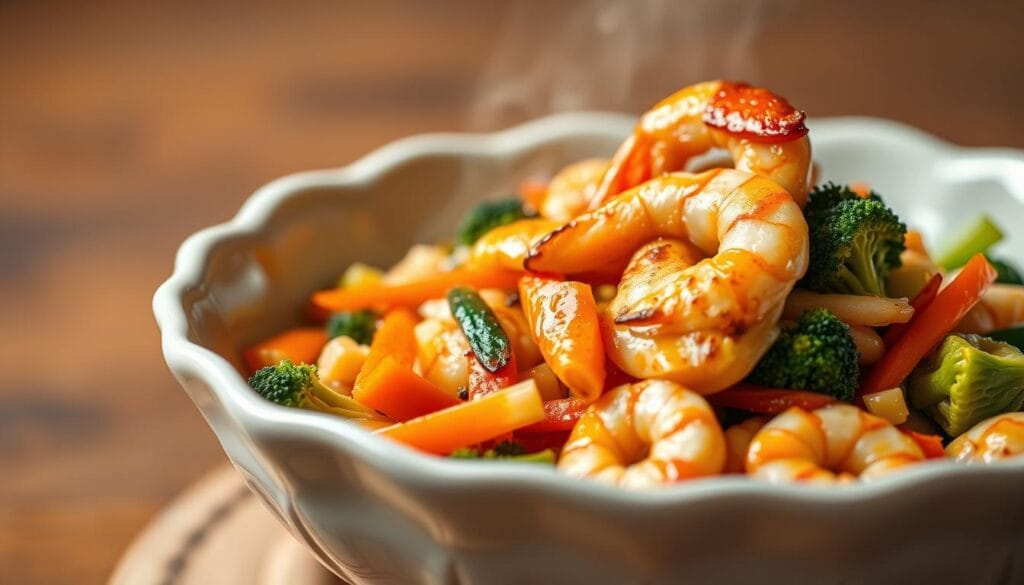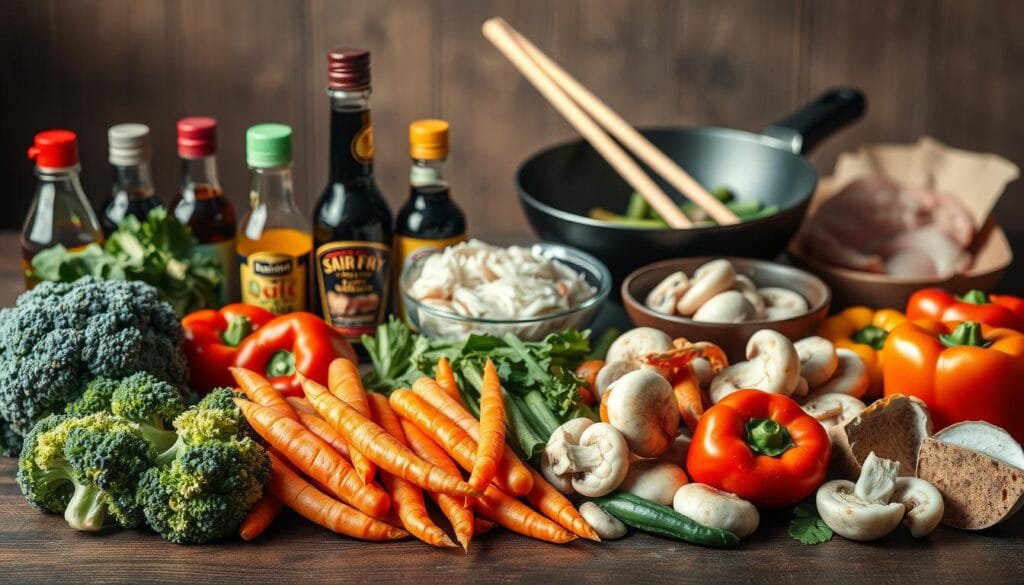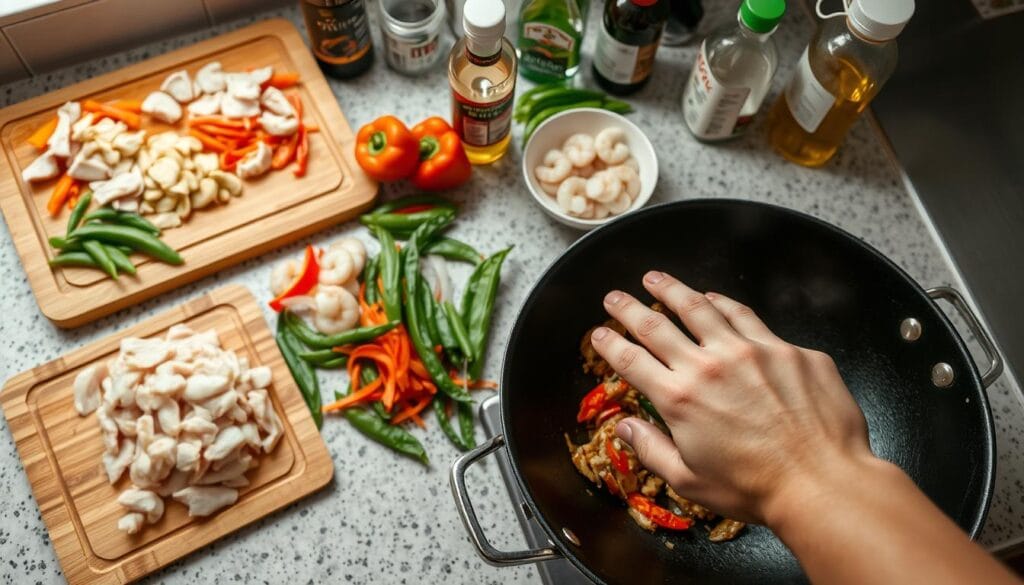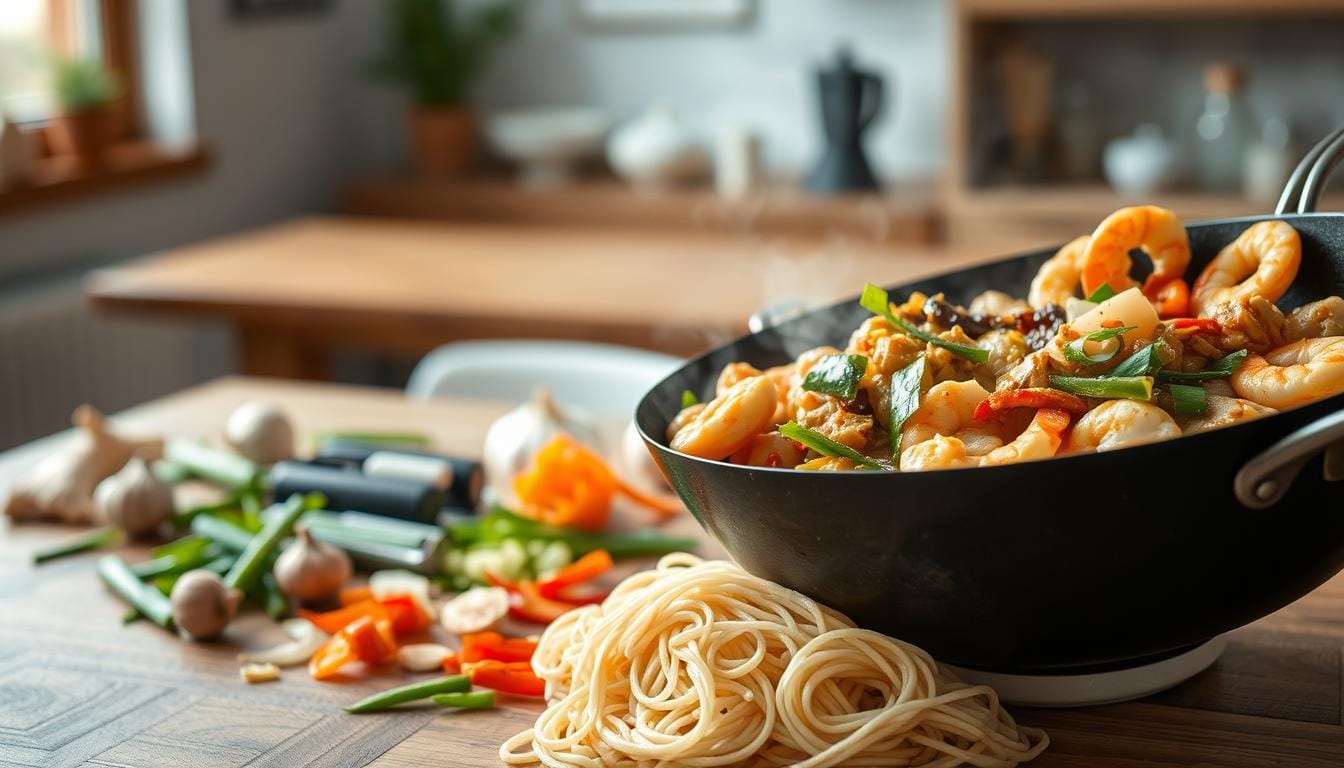Chicken and Shrimp Stir Fry: Quick and Tasty Dinner
Ever stare into your fridge after a long day, hoping dinner will magically assemble itself? We’ve all been there. But what if you could create something truly satisfying—like a chicken and shrimp stir fry—in less time than it takes to debate takeout menus? This protein-packed meal isn’t just about feeding your family—it’s about reclaiming your evening.
“Imagine tender bites seared to perfection in a savory sauce, paired with crisp vegetables that still snap with freshness. Ready in 40 minutes, this dish delivers restaurant-quality flavor without the chaos. It’s the kind of meal that makes you pause mid-bite and think: ‘Why don’t I cook like this more often?'”
Perfect for four people, this combination brings balance to your plate. Vibrant bell peppers, crunchy snap peas, and aromatic garlic come together in a harmony of textures. The best part? You control the ingredients, ensuring every forkful aligns with your taste and nutrition goals.
Key Takeaways
- Ready in 40 minutes – ideal for hectic schedules
- Combines lean proteins with vitamin-rich vegetables
- Customizable sauce adapts to dietary preferences
- Minimal cleanup with one-pan cooking
- Meal prep-friendly for tomorrow’s lunch
Introduction & Benefits of This Dish
Picture this: A sizzling skillet transforms basic pantry staples into a meal that feels like a weekday victory. This recipe’s magic lies in its balance—lean proteins meet crisp vegetables, all hugged by a glossy, flavor-packed sauce. No culinary degree required.

Why You’ll Love This Recipe
Busy nights demand efficiency. Here’s the win: 20-minute active prep and one pan. The sauce—a tangy-sweet blend of soy, honey, and garlic—lifts every ingredient without overpowering. One home cook raves: “It’s become our Thursday night ritual—even my picky eater licks the plate.”
The Appeal of a Quick and Tasty Dinner
Why settle for bland when vibrant tastes are minutes away? Fresh bell peppers add crunch, while snap peas bring color. High heat locks in juices, ensuring tender bites. Best part? Leftovers pack beautifully for lunch—just toss with rice or noodles.
- Protein + veggies = satisfaction: Each forkful delivers nutrition without compromise
- Sauce secrets: Adjust spice levels or swap honey for maple syrup
- Clock-friendly: Faster than pizza delivery, healthier than drive-thru
Grocery stores stock everything you need. Pre-chopped veggies? Use them. Frozen shrimp? Thaw quickly under cold water. This dish adapts to your schedule, not the other way around.
Essential Ingredients & Tools
The magic of a standout meal lies in quality components and proper gear. Let’s break down what you’ll need to build layers of flavor while keeping prep simple. Focus on fresh produce, balanced proteins, and tools that handle high heat like a pro.

Key Proteins: Skinless Chicken & Shrimp
Opt for boneless, skinless breasts sliced thin for quick cooking. Their mild taste absorbs sauces beautifully. For seafood, medium-sized shrimp cook in minutes and pair perfectly with bold seasonings. Both proteins deliver lean fuel without weighing you down.
Fresh Vegetables & Flavorful Sauces
Crunchy red bell peppers and broccoli florets add texture. Snap peas bring sweetness, while garlic and ginger create depth. The sauce ties it all together—combine soy sauce, chili garlic paste, and a touch of honey. Adjust ratios to control saltiness or spice levels.
Must-Have Cooking Equipment
A carbon steel wok distributes heat evenly for perfect searing. No wok? A heavy skillet works too. For larger batches, a flat-top griddle lets you cook everything at once. Keep these essentials handy:
| Tool | Best For | Key Features |
|---|---|---|
| Wok | High-heat tossing | Curved shape prevents burning |
| Skillet | Versatile stovetop use | Nonstick surface for easy cleanup |
| Griddle | Batch cooking | Large surface area |
Measure liquids like stock precisely—a 1½-cup portion balances moisture without making the dish soggy. Pre-cut veggies save time, but fresh ones deliver superior crunch.
Step-by-Step Guide to Making chicken and shrimp stir fry
Ready to transform ingredients into a sizzling masterpiece? Follow this precise method to lock in flavors while keeping textures intact. Organization is key—everything moves fast once the heat’s on.

Preparing the Proteins and Vegetables
Start by patting chicken breast strips dry with paper towels. This ensures a golden sear instead of steaming. Devein seafood thoroughly, leaving tails intact for presentation. Chop crunchy bell pepper and broccoli florets into bite-sized pieces—uniform cuts prevent uneven cooking.
Cooking Sequence in the Skillet or Wok
Heat oil until shimmering. Sear poultry first—3 minutes per side creates caramelized edges. Transfer to a plate and set aside. Add veggies: toss garlic and sliced peppers for 2 minutes until fragrant but crisp.
| Step | Time | Action |
|---|---|---|
| 1 | 3-4 min | Sear proteins |
| 2 | 2-3 min | Sauté vegetables |
| 3 | 1-2 min | Combine components |
Finishing the Dish with Saucy Perfection
Pour sauce ingredients slowly around the pan’s edge. Let it bubble before stirring—this thickens the mixture naturally. Return cooked proteins, then add shrimp. Watch for their signature curl and pink hue, about 90 seconds. Fold everything gently to coat without breaking tender pieces.
Aim for just-cooked seafood and glossy-coated veggies. Serve immediately over steamed rice, garnished with sesame seeds. The entire process clocks in under 25 active minutes—quicker than most delivery apps!
Cooking Techniques & Chef Tips
Mastering heat control separates good home cooks from kitchen wizards. The right tools and tweaks turn basic ingredients into crave-worthy meals. Let’s unlock professional tricks that fit your stovetop setup.
Fire Up Your Wok or Griddle
A screaming-hot surface creates that smoky “wok hei” flavor chefs love. Preheat your pan until water droplets dance and evaporate instantly. For Blackstone griddles, spread proteins in a single layer—overcrowding steams instead of sears.
| Tool | Best Technique | Oil Amount |
|---|---|---|
| Wok | Circular tossing | 1 tbsp |
| Griddle | Zoned cooking | 2 tsp per zone |
Use high-smoke-point oils like avocado or peanut. Add a teaspoon of sesame oil at the end for aroma. Pro tip: Cook proteins first, then veggies—they’ll stay crisp.
Sauce Customization Made Simple
Your sauce is the flavor conductor. Start with 3 parts soy sauce to 1 part honey. Too thick? Splash in water or broth. Want heat? Swirl in chili paste. For brightness, grate fresh ginger into the mix.
- Sweetness swap: Maple syrup instead of honey
- Umami boost: Fish sauce or oyster sauce
- Allergy-friendly: Coconut aminos replace soy
Test adjustments in a small bowl first. Remember: sauces reduce when heated—season lightly initially.
Nutritional Information & Serving Ideas
Let’s talk numbers and nourishment—without the spreadsheet headache. This dish packs smart fuel into every bite while leaving room for creative plating. Discover how to balance macros and elevate your meal presentation effortlessly.
Calorie and Nutrient Breakdown
One serving delivers 421 calories with balanced macros:
- 15g fat (3g saturated)
- 35g carbohydrates
- 32g protein
Heart-healthy fats come from oil and seafood, while lean poultry provides muscle-building protein. Broccoli florets contribute 80% of your daily vitamin C needs per cup.
Creative Sides and Rice Pairings
Grains transform this dish into a complete meal. Consider these combinations:
| Rice Type | Fiber | Cook Time |
|---|---|---|
| White | 0.6g | 15 min |
| Brown | 3.5g | 25 min |
Brown rice offers superior nutrition, but white rice absorbs sauces beautifully. For portion control:
- Use ½ cups cooked grains per plate
- Add steamed broccoli florets for extra crunch
- Try jasmine or basmati for aromatic variety
Leftovers? Pack them with chilled edamame or quick-pickled carrots. The recipe yields 4 generous servings—perfect for meal prep or family dinners. White rice lovers can boost fiber by mixing in quinoa or wild rice blends.
Conclusion
Weeknight dinners just leveled up. This recipe transforms simple ingredients into vibrant meals through smart techniques. Searing proteins first locks in juices, while quick-cooked veggies retain their crunch. The harmony of savory sauce with fresh produce creates restaurant-quality results in your kitchen.
Customization is your secret weapon. Swap soy sauce for coconut aminos or add extra garlic to match your cravings. Balanced portions deliver 32g of protein per serving with under 15g of fat—nutrient-dense fuel that satisfies.
Perfect for four servings, the dish shines with fluffy white rice or zesty cauliflower alternatives. Garnish with sesame seeds for visual flair that impresses guests. Cleanup stays minimal thanks to one-pan efficiency.
Ready to revolutionize your meal routine? Whip up this crowd-pleaser tonight. Tag your creations online—we’d love to see your spin on this versatile classic. Fast, flavorful, and endlessly adaptable, it’s the weeknight hero your skillet deserves.
FAQ
Can I use frozen proteins instead of fresh?
What’s the best substitute for soy sauce?
How do I prevent vegetables from becoming soggy?
Is a wok necessary for this recipe?
Can I make this dish ahead of time?
How do I adjust the sauce for a spicier kick?
What rice pairs best with this stir-fry?
How many calories are in one serving?
Did you like this recipe? Share your thoughts!
There are no reviews yet. Be the first one to write one.

